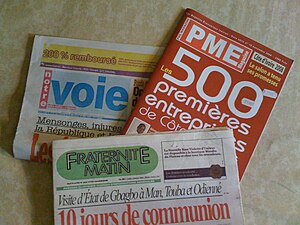
Back Мовы Кот-д’Івуара Byelorussian কোত দিভোয়ারের ভাষা Bengali/Bangla Ieithoedd y Traeth Ifori Welsh Sprachen der Elfenbeinküste German Langues en Côte d'Ivoire French Кот-д’Ивуар тілдері Kazakh Јазици во Брегот на Слоновата Коска Macedonian Языки Кот-д’Ивуара Russian Orodha ya lugha za Cote d'Ivoire Swahili
| Languages of the Ivory Coast | |
|---|---|
 Ivorian newspapers, written in French | |
| Official | French |
| National | About 69 languages: Baoulé, Sénoufo, Yao Una, Agni, Attié (or Akyé), Guéré, Bété, Dyula, Abé, Mahou, Wobé, Lobi, Guro, Mooré |
| Vernacular | African French |
| Foreign | |
| Signed | Francophone African Sign Language |
| Keyboard layout | |


Ivory Coast is a multilingual country with an estimated 69 languages currently spoken.[2] The official language is French. This language is taught in schools and serves as a lingua franca in the country, along with Dioula.
Ivory Coast is a Francophone country, where, as of 2024, 11.630 million (36.42%) out of 31.934 million people speak French.[3]
The 70 or so indigenous languages fall into five main branches of the Niger–Congo family. In the southeastern quadrant are Kwa languages, some such as Baoulé and Anyin (2–3 million and 1 million speakers) part of a dialect continuum with Akan in Ghana, others such as Attié (or Akyé) (half a million) are more divergent. Baoulé is spoken east of Lake Kossou and at the capital Yamoussoukro, and Anyi along the Ghanaian border. In the southwestern quadrant are Kru languages, such as Bete and We (Gure/Wobe), half a million apiece, and Dida (a quarter million), related to the languages of Liberia. In the northwest, along the Guinean border and across to Lake Kossou in the center of the country, are Mande languages, such as Dan (1 million speakers) and Guro (half a million, on the lake). The lake and the river Bandama divide the Kwa east of the country from the Kru and Mande west. Across the center north are various Senufo languages, such as Senari (1 million speakers). In the northeast corner, surrounding Comoé National Park, are a quarter million speakers each of Kulango, the Gur language Lobi, and the Mande language Jula (French: Dioula), which is a lingua franca of neighboring Burkina Faso.
There are also three million or so speakers of immigrant languages, mostly from neighboring countries and above all from Burkina Faso. Ethnic tensions in the north between immigrant and native Ivoirians, as well as between the Mande/Senoufo north and the Kru/Kwa south, were a large factor in the Ivorian civil wars.
Education for the deaf in Ivory Coast uses American Sign Language, introduced by the deaf American missionary Andrew Foster.
- ^ Clem E, Jenks P, Sande H (2019). Clem E, Jenks P, Sande H (eds.). Theory and description in African Linguistics (pdf). Berlin: Language Science Press. doi:10.5281/zenodo.3365789. ISBN 978-3-96110-205-1.
- ^ Lewis, M. Paul (ed.), 2009. Ethnologue: Languages of the World, Sixteenth edition. Dallas, Tex.: SIL International. (Page on "Languages of Côte d’Ivoire." This page indicates that one of the 79 no longer has any speakers.)
- ^ "Accueil-Francoscope". ODSEF (Observatoire démographique et statistique de l'espace francophone de l'Université Laval) (in French). Laval, Québec. Organisation internationale de la Francophonie.
